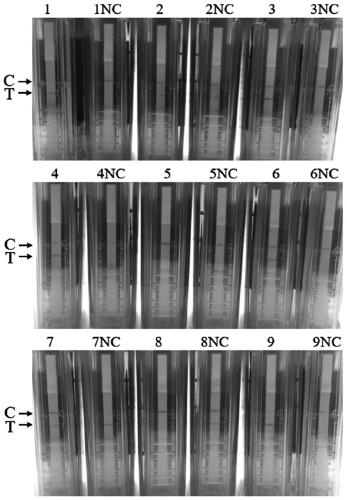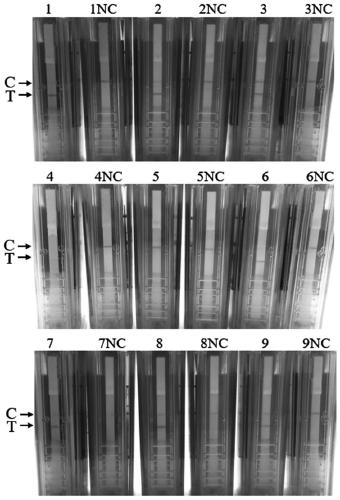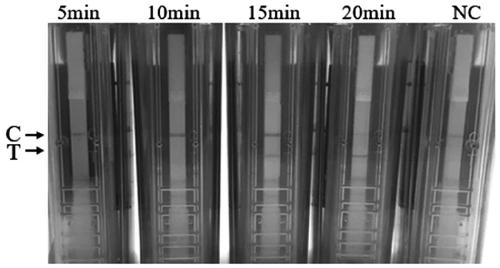RPA method for detecting 21 type human adenovirus, special primer, probe and application thereof
A human adenovirus and probe technology, used in biochemical equipment and methods, DNA/RNA fragments, recombinant DNA technology, etc., can solve the problems of long detection time, reliance on expensive instruments, and inability to apply on-site detection.
- Summary
- Abstract
- Description
- Claims
- Application Information
AI Technical Summary
Problems solved by technology
Method used
Image
Examples
Embodiment 1
[0041] Example 1: Design and screening of detection primers and probes for type 21 human adenovirus RPA
[0042] (1) Design of primers and probes
[0043] The inventor analyzed and determined through literature search that the specific sequence in the hexon gene of type 21 human adenovirus used in the present invention is the target gene. The known template gene sequence was obtained from the NCBI database, i.e. the nucleotide sequence shown in SEQ ID NO.1, and the above sequence was synthesized by Nanjing KingScript Biotechnology Co., Ltd. It can be used as a template in the process of needle screening and optimization of reaction system. According to the principles of RPA primer and probe design, three pairs of primers and one probe were designed, as shown in Table 1.
[0044] Table 1 Primer and probe sequences
[0045]
[0046] (2) Primer screening
[0047] A positive plasmid containing the sequence shown in SEQ ID NO.1 of the 21-type human adenovirus hexon gene was ...
Embodiment 2
[0056] Example 2: Optimization of 21-type human adenovirus RPA reaction system, amplification and detection conditions
[0057] In the process of primer screening, there are still false positives in the detection of lateral flow nucleic acid detection test strips, so the RPA reaction system, amplification and detection conditions need to be optimized
[0058] (1) Primer probe concentration
[0059] Set the concentration gradient of the reverse primer as 10 μmol / L, 5 μmol / L, and 2.5 μmol / L, and the concentration of the probe as 10 μmol / L, 5 μmol / L, and 2.5 μmol / L. The primers were combined with the probes of three concentrations to form 9 combinations, and a set of negative controls was set for each combination. RPA amplification was carried out at 37°C, and the color development of the detection line of the lateral flow nucleic acid detection strip was used as an indicator for the completion of the amplification. The combination with the best amplification effect and no fals...
Embodiment 3
[0068] Example 3: Evaluation of the detection limit of type 21 human adenovirus RPA detection
[0069] Dilute the 21-type human adenovirus positive plasmid into 10-fold ratio 10 - 10 0 A series of different concentrations such as copies / μL, each taking 10 10 、10 9 、10 8 、10 4 、10 3 、10 2 、10 1 Copy / μL of positive plasmid 1 μL was added to the reaction system determined in Example 2, respectively, using the primer combination screened out, using the reaction conditions determined in Example 2 to perform RPA detection on the above templates with different copy numbers, and observe the detection of RPA detection limit.
[0070] see results Figure 4 , from 10 2 Copy / μL begins above sample all to be positive, and negative control is negative, illustrates that the detection limit of RPA detection method of the present invention is 10 2 copy / react.
PUM
 Login to View More
Login to View More Abstract
Description
Claims
Application Information
 Login to View More
Login to View More - R&D
- Intellectual Property
- Life Sciences
- Materials
- Tech Scout
- Unparalleled Data Quality
- Higher Quality Content
- 60% Fewer Hallucinations
Browse by: Latest US Patents, China's latest patents, Technical Efficacy Thesaurus, Application Domain, Technology Topic, Popular Technical Reports.
© 2025 PatSnap. All rights reserved.Legal|Privacy policy|Modern Slavery Act Transparency Statement|Sitemap|About US| Contact US: help@patsnap.com



